Amazons
In Greek mythology, the Amazons (Ancient Greek: Αμαζόνες Amazónes, singular Αμαζών Amazōn) were a tribe of warrior women believed to live in Asia Minor. Apollonius Rhodius, in his Argonautica, mentions that the Amazons were the daughters of Ares and Harmonia (a nymph of the Akmonian Wood), that they were brutal and aggressive, and their main concern in life was war.[1][2] Lysias, Isocrates, Philostratus the Elder also said that their father was Ares. [3][4][5][6]
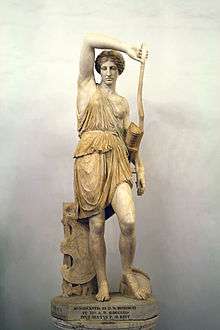
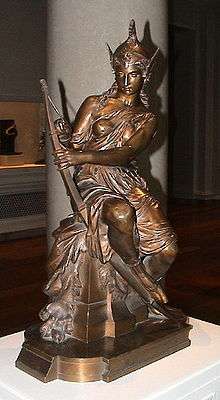
Herodotus and Strabo place them on the banks of the Thermodon River.[7][8] According to Diodorus, giving the account of Dionysius of Mitylene (who in turn drew on Thymoetas), the Amazons inhabited Ancient Libya long before they settled along the Thermodon.[9] Migrating from Libya, these Amazons passed through Egypt and Syria, and stopped at the Caïcus in Aeolis, near which they founded several cities. Later, Diodorus maintains, they established Mytilene a little way beyond the Caïcus.[8] Aeschylus, in Prometheus Bound, places the original home of the Amazons in the country about Lake Maeotis, and from which they moved to Themiscyra on the Thermodon.[8][10] Homer tells that the Amazons were sought and found somewhere near Lycia.[8]
Notable queens of the Amazons are Penthesilea, who participated in the Trojan War, her sister Hippolyta, whose magical girdle, given to her by her father Ares, was the object of one of the labours of Heracles and their mother, Otrera, consort of Ares and the first (and perhaps the most well-known) Amazonian queen. The Amazons fought on the side of Troy against the Greeks during the Trojan War.[11] Diodorus mentions that the Amazons traveled from Libya under Queen Myrina.[8] Amazon warriors were often depicted in battle with Greek warriors in amazonomachies in classical art. Archaeological discoveries of burial sites with female warriors on the Eurasian Steppes suggest that the Scythian women may have inspired the Amazon myth.[12][13] From the early modern period, their name has become a term for female warriors in general. Amazons were said to have founded the cities and temples of Smyrna, Sinope, Cyme, Gryne, Ephesus, Pitania, Magnesia, Clete, Pygela, Latoreria and Amastris; according to legend, the Amazons also invented the cavalry.[14]
Palaephatus, who was trying to rationalize the Greek myths in his On Unbelievable Tales (Ancient Greek: Περὶ ἀπίστων ἱστοριῶν), wrote that the Amazons were probably men who were mistaken for women by their enemies because they wore clothing which reached their feet, tied up their hair in headbands and shaved their beards, and in addition, because they did not exist during his time, most probably they did nοt exist in the past either.[15][16][17] In 2019 a grave with multiple generations of female Scythian warriors in golden headdresses was found near Russia's Voronezh.[18]
Etymology and origins
Etymology
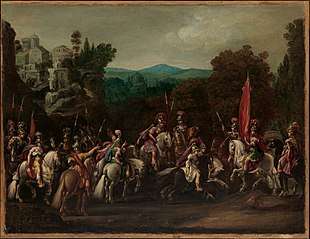
The origin of the word is uncertain. It may be derived from an Iranian ethnonym *ha-mazan- "warriors", a word attested indirectly through a derivation, a denominal verb in Hesychius of Alexandria's gloss "ἁμαζακάραν· πολεμεῖν. Πέρσαι" ("hamazakaran: 'to make war' in Persian"), where it appears together with the Indo-Iranian root *kar- "make".[19]
It may also be derived from *ṇ-mṇ-gw-jon-es "manless, without husbands" (a- privative and a derivation of *man- also found in Slavic muzh) has been proposed, an explanation deemed "unlikely" by Hjalmar Frisk.[20] A further explanation proposes Iranian *ama-janah "virility-killing" as source.[21]
The Hittite researcher Friedrich Cornelius assumes that there had been the land Azzi with the capital Chajasa in the area of the Thermodon-Iris Delta on the coast of the Black Sea. He brings its residents in direct relation to the Amazons, namely based on its name (woman of the land Azzi = 'Am'+ 'Azzi' = Amazon) and its customs (matriarchal custom of promiscuous sexual intercourse, even with blood relatives). The location of that land as well as his conclusions are controversial.
— Gerhard Pollauer[22]
Among Classical Greeks, amazon was given a folk etymology as originating from a- (ἀ-) and mazos (μαζός), "without breast", connected with an etiological tradition once claimed by Marcus Justinus who alleged that Amazons had their right breast cut off or burnt out.[23] There is no indication of such a practice in ancient works of art,[24] in which the Amazons are always represented with both breasts, although one is frequently covered.[25][24] Adrienne Mayor suggests that the false etymology led to the myth.[24][26]
Origins

Herodotus and Strabo placed the Amazons on the banks of the Thermodon (today's Terme river) and Themiscyra (probably close to the modern city of Terme).[7][8] Herodotus also mentions that some Amazons lived in Scythia because after the Greeks defeated the Amazons in battle, they sailed away carrying in three ships as many Amazons as they had been able to take alive, but out at sea the Amazons attacked the crews and killed them, then these Amazons landed on Scythian lands.[27] Strabo writes that the original home of the Amazons was in Themiscyra and the plains about Thermodon and the mountains that lie above them, but that they were later driven out of these places, and during his time they were said to live in the mountains above Caucasian Albania (not to be confused with the modern Albania). But he also states that some others, among them Metrodorus of Scepsis and Hypsicrates, say that after Themiscyra, the Amazons traveled and lived on the borders of the Gargarians, in the northerly foothills of those parts of the Caucasian Mountains which are called Ceraunian.[28]
Aeschylus, in Prometheus Bound, places the original home of the Amazons in the country about Lake Maeotis and they later moved to Themiscyra on the Thermodon.[8][10] Homer had placed the Amazons much closer to the Greek world of his times, saying that the Amazons were sought and found somewhere near Lycia.[8]
Diodorus Siculus, giving the account of Dionysius of Mitylene, who, on his part, drew on Thymoetas, states that before the Amazons of the Thermodon there were, much earlier in time, the Amazons of Libya.[9] These Amazons started from Libya passed through Egypt and Syria, and stopped at the Caïcus in Aeolis, near which they founded several cities. Later, he says, they established Mitylene a little way beyond the Caïcus.[8]
Plutarch mentions that the campaigns of Heracles and Theseus against the Amazons took place on the Euxine Sea (the modern Black Sea).[29] According to Pseudo-Plutarch, the Amazons lived in and about the Tanais (Greek: Τάναϊς) river (modern Don river), formerly called the Amazonian or Amazon (Greek: Ἀμαζόνιος) river, because the Amazons bathed themselves therein.[30] The Amazons later moved to Themiscyra (speculated to be modern Terme, though no ruins exist) on the River Thermodon (the Terme river in northern Turkey).
The Amazons were supposed to have founded many towns, amongst them Smyrna, Ephesus, Cyme, Myrina, Sinope, Paphos, Mitylene.[28][8] At Patmos there was a place called Amazonium.[8][31] Also, on the island of Lemnos, there was another Myrina.[8] The cities of Myrina had this name after the amazon Myrina.
Apollonius Rhodius, in his Argonautica (third century BC), mentions that at Thermodon the Amazons were not gathered together in one city, but scattered over the land, parted into three tribes. In one part dwelt the Themiscyreians (Θεμισκύρειαι), in another the Lycastians (Λυκάστιαι), and in another the Chadesians (Χαδήσιαι).[2]
Other names
Greeks also used other descriptive phrases for them. Herodotus used the Androktones (Ἀνδροκτόνες, singular Ἀνδροκτόνα, Androktonα) ("killers/slayers of men")[7] and Androleteirai (Ἀνδρολέτειραι, singular Ἀνδρολέτειρα, Androleteira) ("destroyers of men, murderesses"),[8] in the Iliad they are also called Antianeirai (Ἀντιάνειραι, singular Ἀντιάνειρα, Antianeira) ("equivalent to men") and Aeschylus used the Styganor (Στυγάνωρ) ("those who loathe all men")[10][32] in his work Prometheus Bound and in the Suppliant Maidens he called them "...τὰς ἀνάνδρους κρεοβόρους τ᾽ Ἀμαζόνας" ("the unwed, flesh-devouring Amazons").[33] In Hippolytus play, Phaedra calls Hippolytus, "the son of the horse-loving Amazon" (...τῆς φιλίππου παῖς Ἀμαζόνος βοᾷ Ἱππόλυτος...).[34] Nonnus at Dionysiaca call the Amazons of Dionysus, Androphonus (Ἀνδροφόνους) ("men slaying").[35]
Herodotus stated that in the Scythian language they were called Oiorpata, oior meaning "man", and pata meaning "to slay".[7]
Historical background
Classicist Peter Walcot wrote, "Wherever the Amazons are located by the Greeks, whether it is somewhere along the Black Sea in the distant north-east, or in Libya in the furthest south, it is always beyond the confines of the civilized world. The Amazons exist outside the range of normal human experience."[36]
Nevertheless, there are various proposals for a historical nucleus of the Amazons of Greek historiography, the most obvious candidates being historical Scythia and Sarmatia in line with the account by Herodotus, but some authors prefer a comparison to cultures of Asia Minor or even Minoan Crete.
Mythology
The Amazons and Troy
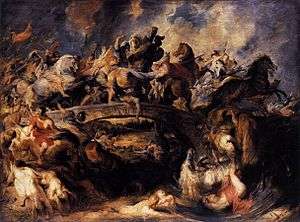
The Amazons appear in Greek art of the Archaic period and in connection with several Greek legends and myths. According to the Iliad, Amazons attacked the Phrygians, who were assisted by Priam, then a young man.[37] In his later years, however, towards the end of the Trojan War, his old opponents took his side against the Greeks under their queen Penthesilea "of Thracian birth", who was slain by Achilles.[25][38][39][40][41][42][43] The Lycian King Iobates sent Bellerophon against the Amazons, hoping that they would kill him, but Bellerophon killed them all.[44][45][46]
The tomb of Myrine is mentioned in the Iliad;[47] later interpretation made an Amazon of her. According to Diodorus, the Amazons under the rule of Queen Myrina, invaded the lands of the Atlantians. Amazons defeated the army of the Atlantian city of Cerne, treated the captives savagely, killed all the men, led into slavery the children and women, and razed the city. When the terrible fate of the inhabitants of Cerne became known among the other Atlantians, they were struck with terror, surrendered their cities on terms of capitulation and announced that they would do whatever should be commanded them. Queen Myrina bearing herself honourably towards the Atlantians, established friendship with them and founded a city to bear her name in place of the city of Cerne which had been razed; and in it she settled both the captives and any native who so desired. Atlantians presented her with magnificent presents and by public decree voted to her notable honours, and she in return accepted their courtesy and in addition promised that she would show kindness to their nation. Diodorus also mentions that the Amazons of Queen Myrina used the skins of gigantic snakes, from Libya, to protect themselves at battle. Later Queen Myrine led her Amazons to victory against the Gorgons. After the battle against the Gorgons, Myrina accorded a funeral to her fallen comrades on three pyres and raised up three great heaps of earth as tombs, which are called "Amazon Mounds" (Greek: Ἀμαζόνων σωρούς).[9]
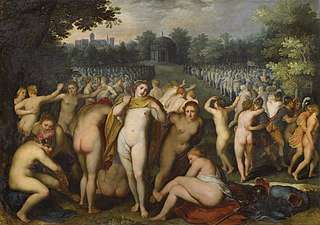
Dealings with the Scythians
Herodotus mentions that when Greeks defeated the Amazons at war, they sailed away carrying in three ships as many Amazons as they had been able to take alive, out at sea the Amazons attacked the crews and killed them. But the Amazons knew nothing about ships so they were driven about by waves and winds and they were disembarked at the land of the Scythians. There they met first with a troop of horses feeding, they seized them and mounted upon these they plundered the property of the Scythians. The Scythians were not able to understand them because they did not know either their speech or their dress or the race to which they belonged, and they thought that they were men. Scythians fought a battle against them, and after the battle the Scythians got possession of the bodies of the dead, and thus they discovered that they were women. After the battle Scythians sent young men and told them to encamp near the Amazons and to do whatsoever they should do. If the women should come after them, they were not to fight but to retire before them, and when the women stopped, they were to approach near and encamp.
This plan was adopted by the Scythians because they desired to have children born from them. When the Amazons perceived that they had not come to do them any harm, they let them alone; and the two camps approached nearer to one another every day: and the young men, like the Amazons, had nothing except their arms and their horses and got their living, as the Amazons did, by hunting and by taking booty. One day a Scythian and an Amazon came close. They could not speak to each other because they were speaking different languages, but the Amazon made signs to him with her hand to come. Later the young Scythians and the Amazons joined their camps and lived together, each man having for his wife her with whom he had had dealings at first. The men were not able to learn the language of the Amazons, but the women learned Scythian.[7]
The Amazons in their homeland
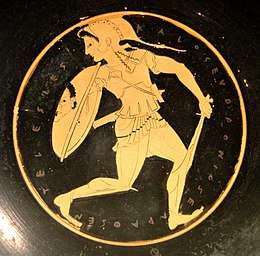
In some versions of the myth, the Amazons lived always isolated from men, communicating with them only to reproduce, and raising only female offspring.[11] As Sue Blundell notes in her modern work, Women in Ancient Greece, "For... [some] ancient authors the Amazons, in spite of their separatist habits, were not immune to the lure of sexual desire", and went on to cite a story from Herodotus.[48] The article on the Amazons in the 1911 Encyclopædia Britannica argues—based on the evidence available at that time—that while men were not permitted to have sexual encounters or reside in Amazon country, the Amazons visited the Gargareans, a neighbouring tribe, once a year, in order to prevent their race from dying out.[25] Strabo, giving credits to Metrodorus of Scepsis and Hypsicrates, mentions that at his time the Amazons were believed to live on the borders of the Gargareans. There were two special months in the spring in which they would go up into the neighboring mountain which separates them and the Gargareans. The Gargareans also, in accordance with an ancient custom, would go there to offer sacrifice with the Amazons and also to have intercourse with them for the sake of begetting children. They did this in secrecy and darkness, any Gargareans at random with any Amazon, and after making them pregnant they would send them away. Any females that were born are retained by the Amazons themselves, but the males would be taken to the Gargareans to be brought up; and each Gargarean to whom a child is brought would adopt the child as his own, regarding the child as his son because of his uncertainty.[28]
Strabo also stated that the Gargareans went up from Themiscyra into this region with the Amazons, then, in company with some Thracians and Euboeans who had wandered thus far, waged war against them. They later ended the war against the Amazons and made a compact that they should have dealings with one another only in the matter of children, and that each people should live independent of the other.[28] In addition, he states that the right breasts of all Amazons are seared when they are infants, so that they can easily use their right arm for every needed purpose, and especially that of throwing the javelin and using the bow.[28]
Apollonius Rhodius, in his Argonautica, mentions that Amazons were the daughters of Ares and Harmonia (a nymph of the Akmonian Wood). They were brutal and aggressive, and their main concern in life was war.[1][2] According to him, the Amazons were not gathered together in one city, but scattered over the land, parted into three tribes. In one part dwelt the Themiscyreians (Θεμισκύρειαι), in another the Lycastians (Λυκάστιαι), and in another the Chadesians (Χαδήσιαι).[49] Also, he mentions that on an island, the Queens of the Amazons, Otrere (Ὀτρηρή) and Antiope (Ἀντιόπη), built a marble temple to Ares. On this desert island there were ravening birds, which in countless numbers haunt it.[50] The island mentioned is the Aretias.[51] Argonauts passed by Themiscyra on their journey to Colchis. Zeus sent Boreas (the North Wind), and with his help the Argonauts stood out from the shore near Themiscyra where the Themiscyreian Amazons were arming for battle.[52][53][54][55]
Battles with Hercules and Theseus, dealings with Alexander the Great
One of the tasks imposed upon Hercules by the king of Tyrins, Eurystheus, was to obtain possession of the girdle of the Amazonian queen Hippolyta.[56][57][58][59] He was accompanied by his friend Theseus, who carried off the princess Antiope, sister of Hippolyta, an incident which led to a retaliatory invasion of Attica,[60][61] in which Antiope perished fighting by the side of Theseus.[25] First Hippolyte had been favorable to gift the girdle to Heracles, but Hera, disguised as Hippolyte, started the war.[11] Sthenelus was killed during the war.[62] In some versions, however, Theseus marries Hippolyta and in others, he marries Antiope and she does not die; by this marriage with the Amazon Theseus had a son Hippolytus. In another version of this myth, Theseus made this voyage on his own account, after the time of Heracles.[29]
The battle between the Athenians and Amazons is often commemorated in an entire genre of art, amazonomachy, in marble bas-reliefs such as from the Parthenon or the sculptures of the Mausoleum of Halicarnassus. In The Eumenides, Athena says to the citizens of Attica that Amazons used the Areopagus as a camp during their campaign against Athens and Theseus.[63] Plutarch, in his Parallel Lives (The Life of Theseus), mentions that Bion said that the Amazons, were naturally friendly to men, and did not fly from Theseus when he touched upon their coasts.[29]
Amazons are also heard of in the time of Alexander, when some of the king's biographers make mention of the Amazon Queen Thalestris visiting him and becoming a mother by him (the story is known from the Alexander Romance).[64] However, several other biographers of Alexander dispute the claim, including the highly regarded secondary source, Plutarch. In his writing he makes mention of a moment when Alexander's secondary naval commander, Onesicritus, was reading the Amazon passage of his Alexander history to King Lysimachus of Thrace who was on the original expedition: the king smiled at him and said "And where was I, then?"[65]
Battles with and against Dionysus
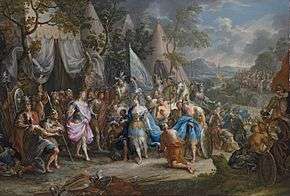
According to Plutarch, when the god Dionysus and his entourage fought the Amazons at Ephesus, the Amazons fled to Samos. Dionysus pursued them and at Samos he killed a great number of them on a spot which was, from that occurrence, called Panaema (Πάναιμα), which means blood-soaked field.[66][67] The Christian author Eusebius writes that during the reign of Oxyntes, one of the mythical kings of Athens, the Amazons burned down the temple at Ephesus.[68]
In another myth Dionysus united with the Amazons to fight against Cronus and the Titans.[69] Polyaenus writes that after Dionysus had subdued the Indians, he formed an alliance with them and the Amazons, and took them into his service. He later used them in his campaign against the Bactria.[70] Nonnus in his Dionysiaca writes about the Amazons of Dionysus, but he says that they were not from Thermodon.[35]
Afterlife of a myth
Magnes (Ancient Greek: Μάγνης), a poet from Smyrna had sung of the bravery of Lydians in a cavalry-battle against the Amazons.[71]
Virgil's characterization of the Volscian warrior maiden Camilla in the Aeneid borrows heavily from the myth of the Amazons. Philostratus, in Heroica, writes that the Mysian women fought from horses alongside the men, just as the Amazons did, and the leader was Hiera (Ancient Greek: Ἱερὰ), wife of Telephus.
The Amazons are also said to have undertaken an expedition against the island of Leuke, at the mouth of the Danube, where the ashes of Achilles had been deposited by Thetis. The ghost of the dead hero appeared and so terrified the horses, that they threw and trampled upon the invaders, who were forced to retire. Pompey is said to have found them in the army of Mithridates.[25]
Jordanes' Getica (c. 560 CE), purporting to give the earliest history of the Goths, relates that the Goths' ancestors, descendants of Magog, originally dwelt within Scythia, on the Sea of Azov between the Dnieper and Don Rivers. After a few centuries, following an incident where the Goths' women successfully fended off a raid by a neighboring tribe, while the menfolk were off campaigning against Pharaoh Vesosis, the women formed their own army under Marpesia and crossed the Don, invading Asia. Her sister Lampedo remained in Europe to guard the homeland. They procreated with men once a year. These Amazons conquered Armenia, Syria, and all of Asia Minor, even reaching Ionia and Aeolis, holding this vast territory for 100 years. Jordanes also mentions that they fought with Hercules, and in the Trojan War, and that a smaller contingent of them endured in the Caucasus Mountains until the time of Alexander. He mentions by name the Queens Menalippe, Hippolyta, and Penthesilea.
In the Grottaferrata Version of Digenes Akritas, the twelfth century medieval epic of Basil, the Greek-Syrian knight of the Byzantine frontier, the hero battles with and kills the female warrior Maximo, descended from some Amazons and taken by Alexander from the Brahmans.[72]
Names
There are several lists of names of Amazons.
Quintus Smyrnaeus
Quintus Smyrnaeus[73] lists the attendant warriors of Penthesilea: "Clonie was there, Polemusa, Derinoe, Evandre, and Antandre, and Bremusa, Hippothoe, dark-eyed Harmothoe, Alcibie, Derimacheia, Antibrote, and Thermodosa glorying with the spear."
Diodorus Siculus
Diodorus Siculus[74] lists twelve Amazons who challenged Heracles to single combat during his quest for Hippolyta's girdle and died against him one by one: Aella, Philippis, Prothoe, Eriboea, Celaeno, Eurybia, Phoebe, Deianeira, Asteria, Marpe, Tecmessa, Alcippe. After Alcippe's death, a group attack followed. She also mentions Melanippe, who he set free after accepting her girdle as ransom and Antiope, who he gifted to Theseus.
Diodorus also lists another group of Amazons in book 3[75][9]. He mentions Myrina as the queen who commanded the Amazons in a military expedition in Libya, as well as her sister Mytilene, after whom she named the city of the same name. Myrina also named three more cities after the Amazons who held the most important commands under her, Cyme, Pitane, and Priene.
Justin and Paulus Orosius
Both Justin in his Epitome of Trogus Pompeius[76] and Paulus Orosius[77] give an account of the Amazons, citing the same names. Queens Marpesia and Lampedo shared the power during and incursion in Europe and Asia, where they were slain. Marpesia's daughter Orithyia succeeded them and was greatly admired for her skill on war. She shared power with her sister Antiope, but she was engaged in war abroad when Heracles attacked. Two of Antiope's sisters were taken prisoner, Menalippe by Heracles and Hippolyta by Theseus. Heracles latter restored Menalippe to her sister after receiving the queen's arms in exchange, though, on other accounts[78] she was killed by Telamon. They also mention Penthesilea's role in the Trojan War.
Justin is the only who mentions another queen, Minithya or Thalestris, who shared the bed of Alexander the Great in order to conceive, while Paulus mentions Sinope, successor of Lampedo and Marpesia.
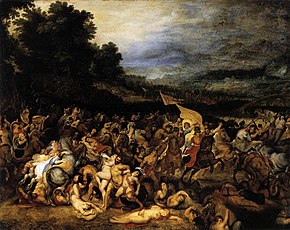
Hyginus
Another list of Amazons' names is found in Hyginus' Fabulae.[79] Along with Hippolyta, Otrera, Antiope and Penthesilea, it attests the following names: Ocyale, Dioxippe, Iphinome, Xanthe, Hippothoe, Laomache, Glauce, Agave, Theseis, Clymene, Polydora.
Perhaps the most important is Queen Otrera, consort of Ares and mother by him of Hippolyta[80] and Penthesilea[81][82]. She's also known for building a temple to Artemis at Ephesus.[83][84]
Valerius Flaccus
Another different set of names is found in Valerius Flaccus' Argonautica:[85] he mentions Euryale, Harpe, Lyce, Menippe and Thoe. Of these Lyce also appears in a fragment preserved in the Latin Anthology where she is said to have killed the hero Clonus of Moesia, son of Doryclus, with her javelin.[86]
John Tzetzes
John Tzetzes in Posthomerica[87] enumerates the Amazons who fell at Troy: Hippothoe, Antianeira, Toxophone, Toxoanassa, Gortyessa, Iodoce, Pharetre, Andro, Ioxeia, Oïstrophe, Androdaïxa, Aspidocharme, Enchesimargos, Cnemis, Thorece, Chalcaor, Eurylophe, Hecate, Anchimache and Andromache the queen. For almost all the names on the list, except Antianeira and Andromache, this is a unique attestation.
Stephanus of Byzantium and Eustathius
Stephanus of Byzantium provides an alternate list of the Amazons who fell against Heracles, describing them as "the most prominent" of their people: Tralla, Isocrateia, Thiba, Palla, Coea (Koia), Coenia (Koinia).[88] Eustathius gives the same list minus the last two names.[89] Both Stephanus and Eustathius write of these Amazons in connection with the placename Thibais, which they report to have been derived from Thiba's name.
Stephanus also mentions other Amazons in other entries of his work:
- Amastris, who was believed to be the eponym of the city previously known as Kromna,[90] although the city was actually named after the historical Amastris.[91]
- Anaea, an Amazon whose tomb was shown at the island of Samos.[92] In addition, the city Anaea in Caria was named after the Amazon.[93]
- Cyme, who gave her name to the city of Cyme (Aeolis).[94]
- Cynna (?), one of the two possible eponyms (the other one being "Cynnus, brother of Coeus") of Cynna, a small town not far from Heraclea.[95]
- Ephesos, a Lydian Amazon, after whom the city of Ephesus was thought to have been named; she was also said to have been the first to honor Artemis and to have surnamed the goddess Ephesia.[96] Her daughter Amazo was thought of as the eponym of the Amazons.[97]
- Myrleia, possible eponym of a city in Bithynia, which was later known as Apamea.[98]
- Sisyrbe, after whom a part of Ephesus was called Sisyrba, and its inhabitants the Sisyrbitae.[99][100]
- Smyrna, who obtained possession of Ephesus and gave her name to a quarter in this city, as well as to the city of Smyrna.[101][102][103]
Other names
Other names of Amazons from various sources include:
- Aegea, queen of the Amazons who was thought by some to have been the eponym of the Aegean Sea.[104]
- Ainia, presumably accompanied Penthesilea to the Trojan War, killed by Achilles; known only from an Attic terracotta relief fragment.[105]
- Ainippe, an Amazon who confronted Telamon in the battle against Heracles' troops.[106]
- Alce, who was said to have killed the young Oebalus of Arcadia, son of Ida (otherwise unknown), with her spear during the Parthian War.[86]
- Andromache, an Amazon who fought Heracles and was defeated; only known from vase paintings.[106][107] Not to be confused with Andromache, wife of Hector. She was portrayed by Charlize Theron in the film, The Old Guard.
- Antianeira, succeeded Penthesilea as Queen of the Amazons. She was best known for ordering her male servants to be crippled "as the lame best perform the acts of love".[108]
- Areto and Iphito, two little-known Amazons, whose names are only attested in inscriptions on artefacts.[109]
- Clete, one of the twelve followers of Penthesilea. After Penthesilea's death she, in accord with the former's will, sailed off and eventually landed in Italy, founding the city of Clete.[110]
- Eurypyle, queen of the Amazons who was reported to have led an expedition against Ninus and Babylon around 1760 BC.[111][112][113]
- Gryne, an Amazon who was thought to be the eponym of the Gryneian grove in Asia Minor. She was loved by Apollo and consorted with him in said grove.[114][115]
- Helene, daughter of Tityrus. She fought Achilles and died after he gravely wounded her.[116]
- Hippo, an Amazon who took part in the introduction of religious rites in honor of the goddess Artemis. She was punished by the goddess for not having performed a ritual dance.[117]
- Latoreia, who had a small village near Ephesus named after her.[118]
- Lysippe, mother of Tanais by Berossos. Her son only venerated Ares and was fully devoted to war, neglecting love and marriage. Aphrodite cursed him with falling in love with his own mother. Preferring to die rather than give up his chastity, he threw himself into the river Amazonius, which was subsequently renamed Tanais.[119]
- Molpadia, an Amazon who killed Antiope.[120]
- Myrto, in one source, mother of Myrtilus by Hermes[121] (elsewhere his mother is called Theobule).[122]
- Pantariste, who killed Timiades in the battle between the Amazons and Heracles' troops.[106]
- Sanape, who fled to Pontus and married a local king. "Sanape" means "from wine country" in Circassian. According to a commentary, it was purported to mean "drunkard" in the local language.[123]
- Themiscyra, the eponym of the Amazon capital.[124][125]
Hero cults
According to ancient sources (Plutarch, Theseus,[126] Pausanias), Amazon tombs could be found frequently throughout what was once known as the ancient Greek world. Some are found in Megara, Athens, Chaeronea, Chalcis, Thessaly at Skotousa, in Cynoscephalae, and statues of Amazons are all over Greece. Stephanus of Byzantium, quoting Ephorus, mention that the tomb of the amazon Anaea (Ἀναία) was at the city of Anaea (Ἄναια), which also has this name after the amazon.[127]
At both Chalcis and Athens, Plutarch tells us that there was an Amazoneum or shrine of Amazons that implied the presence of both tombs and cult. At the entrance of Athens there was a monument to the Amazon Antiope.[128] On the day before the Thesea at Athens there were annual sacrifices to the Amazons. In the Axiochus, mention about an Amazonian stele near the Itonian Gate at Athens.[129] In historical times Greek maidens of Ephesus performed an annual circular dance with weapons and shields that had been established by Hippolyta and her Amazons. They had initially set up wooden statues of Artemis, a bretas (Pausanias, (fl. c. AD 160): Description of Greece, Book I: Attica).[130]
Harpokration mention that Ammonius of Athens in his book "On Altars and Sacrifices" writes that the Amazons founded the Amazoneion sanctuary at Athens.[131]
In art
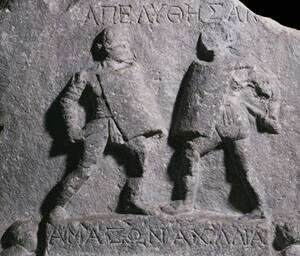
In works of art, battles between Amazons and Greeks are placed on the same level as – and often associated with – battles of Greeks and centaurs. The belief in their existence, however, having been once accepted and introduced into the national poetry and art, it became necessary to surround them as far as possible with the appearance of natural beings. Amazons were therefore depicted in the manner of Scythian or Sarmatian horsemen. Their occupation was hunting and war; their arms the bow, spear, axe, a half shield, nearly in the shape of a crescent, called pelta, and in early art a helmet. The model in the Greek mind had apparently been the goddess Athena. In later art they approach the model of Artemis, wearing a thin dress, girt high for speed; while on the later painted vases their dress is often peculiarly Persian – that is, close-fitting trousers and a high cap called the kidaris. They were usually on horseback but sometimes on foot.[25] This depiction of Amazons demonstrates just how closely, in the Greek mind, the Amazons were linked to the Scythians. Their manner of dress has been noted to bear a striking similarity to the traditional dress of nomadic peoples from the Crimea to Mongolia.[132] Amazons were described by Herodotus as wearing trousers and having tall stiff caps.[133] The double-sided axe was the most emblematic of their weapons.[14] Amazons can also be identified in vase paintings by the fact that they are wearing one earring. The battle between Theseus and the Amazons (Amazonomachy) is a favourite subject on the friezes of temples (e.g. the reliefs from the frieze of the Temple of Apollo at Bassae, now in the British Museum), vases and sarcophagus reliefs; at Athens it was represented on the shield of the statue of Athena Parthenos, on wall-paintings in the Theseum and in the Stoa Poikile.[25] There were also three standard Amazon statue types.
In the Essays in Portraiture, Lucian of Samosata ask Polystratos which, he think, is the best work of Phidias and Polystratos respond "The Lemnian Athene, which bears the artist's own signature; and of course the Amazon leaning on her spear."[134]
Later in the Renaissance, as Amazon myth evolved, artists started to depict warrior women in a new light. Queen Elizabeth was often thought of as an Amazon-like warrior during her reign and was sometimes depicted as such. Though, as explained in Divinia Viagro by Winfried Schleiner, Celeste T. Wright "has given a detailed account of the bad press Amazons had in the Renaissance (with respect to their unwomanly conduct and Scythian cruelty). She notes that she has not found any Elizabethans comparing the queen directly to an Amazon, and suggests that they might have hesitated to do so because of the association of Amazons with enfranchisement of women, which was considered contemptible."[135]
Peter Paul Rubens and Jan Brueghel depicted the Battle of the Amazons around 1598, showing many attributes of Renaissance-styled paintings. Amazons also appear in the Rococo period in another painting titled Battle of the Amazons by Johann Georg Platzer. As a part of the Romantic period revival, German artist Anselm Feuerbach painted the Amazons as well. His paintings “engendered all the aspirations of the Romantics: their desire to transcend the boundaries of the ego and of the known world; their interest in the occult in nature and in the soul; their search for a national identity, and the ensuing search for the mythic origins of the Germanic nation; finally, their wish to escape the harsh realities of the present through immersion in an idealized past.[136]”
In historiography
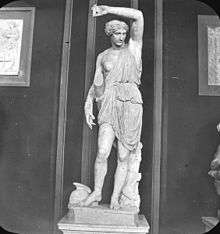
Herodotus reported that the Sarmatians were descendants of Amazons and Scythians, and that their wives observed their ancient maternal customs, "frequently hunting on horseback with their husbands; in war taking the field; and wearing the very same dress as the men". Moreover, said Herodotus, "No girl shall wed till she has killed a man in battle". In the story related by Herodotus, a group of Amazons was blown across the Maeotian Lake (the Sea of Azov) into Scythia near the cliff region (today's southeastern Crimea). After learning the Scythian language, they agreed to marry Scythian men, on the condition that they not be required to follow the customs of Scythian women. According to Herodotus, this band moved toward the northeast, settling beyond the Tanais (Don) river, and became the ancestors of the Sauromatians. According to Herodotus, the Sarmatians fought with the Scythians against Darius the Great in the 5th century BC.
Xenophon in Anabasis writes that Democrates of Temnus captured a man with a Persian bow, a quiver and a battleaxe of the same sort that Amazons carry.[137]
Hippocrates describes them as: "They have no right breasts...for while they are yet babies their mothers make red-hot a bronze instrument constructed for this very purpose and apply it to the right breast and cauterize it, so that its growth is arrested, and all its strength and bulk are diverted to the right shoulder and right arm."[138]
Amazons came to play a role in Roman historiography. Caesar reminded the Senate of the conquest of large parts of Asia by Semiramis and the Amazons. Successful Amazon raids against Lycia and Cilicia contrasted with effective resistance by Lydian cavalry against the invaders (Strabo 5.504; Nicholas Damascenus). Gnaeus Pompeius Trogus pays particularly detailed attention to the Amazons. The story of the Amazons as deriving from a Cappadocian colony of two Scythian princes Ylinos and Scolopetos is due to him. Pliny the Elder records some surprising facts pointing to the valley of the Terme River as possibly being their home: a mountain named for them (the modern Mason Dagi), as well as a settlement Amazonium; Herodotus (VI.86) first mentions their capital Themiscyra, which Pliny locates near the Terme.[139] Philostratus places the Amazons in the Taurus Mountains. Ammianus places them east of Tanais, as neighbouring the Alans. Procopius places them in the Caucasus. Diodorus Siculus (Bibliotheca historica III, chapter 52) mentioned that besides Pontus Amazons existed much older race (at that time entirely disappeared) of Amazons from western Libya, and retells their mythological story which includes Atlantis and Greek mythology.
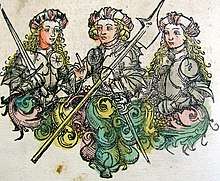
Although Strabo shows skepticism as to their historicity, the Amazons in general continue to be taken as historical throughout Late Antiquity. Several Church Fathers speak of the Amazons as of a real people. Solinus embraces the account of Pliny. Under Aurelianus, captured Gothic women were identified as Amazons (Claudianus). The account of Justinus was influential, and was used as a source by Orosius who continued to be read during the European Middle Ages. Medieval authors thus continue the tradition of locating the Amazons in the North, Adam of Bremen placing them at the Baltic Sea and Paulus Diaconus in the heart of Germania.[140]
Pausanias at the Description of Greece writes that near Pyrrhichus there were sanctuaries of the gods Artemis, called Astrateia (Ancient Greek: Ἀστρατείας), and Apollo, called Amazonius (Ancient Greek: Ἀμαζόνιος) with images of the gods said to have been dedicated by the women from Thermodon.[141]
Medieval and Renaissance literature
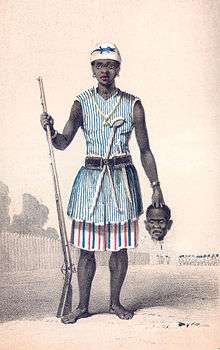
Amazons continued to be discussed by authors of the European Renaissance, and with the Age of Exploration, they were located in ever more remote areas. In 1542, Francisco de Orellana reached the Amazon River (Amazonas in Spanish), naming it after a tribe of warlike women he claimed to have encountered and fought on the Nhamundá River, a tributary of the Amazon.[142] Afterwards the whole basin and region of the Amazon (Amazônia in Portuguese, Amazonía in Spanish) were named after the river. Amazons also figure in the accounts of both Christopher Columbus and Walter Raleigh.[143] Famous medieval traveller John Mandeville mentions them in his book:
Beside the land of Chaldea is the land of Amazonia, that is the land of Feminye. And in that realm is all woman and no man; not as some may say, that men may not live there, but for because that the women will not suffer no men amongst them to be their sovereigns.[144]
Medieval and Renaissance authors credit the Amazons with the invention of the battle-axe. This is probably related to the sagaris, an axe-like weapon associated with both Amazons and Scythian tribes by Greek authors (see also Thracian tomb of Aleksandrovo kurgan). Paulus Hector Mair expresses astonishment that such a "manly weapon" should have been invented by a "tribe of women", but he accepts the attribution out of respect for his authority, Johannes Aventinus.
Ariosto's Orlando Furioso contains a country of warrior women, ruled by Queen Orontea; the epic describes an origin much like that in Greek myth, in that the women, abandoned by a band of warriors and unfaithful lovers, rallied together to form a nation from which men were severely reduced, to prevent them from regaining power. The Amazons and Queen Hippolyta are also referenced in Geoffrey Chaucer's Canterbury Tales in "The Knight's Tale".
Archaeology
Scythians and Sarmatians
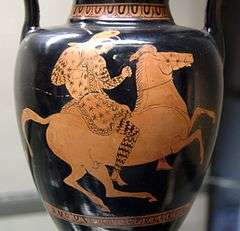
Speculation that the idea of Amazons contains a core of reality is based on archaeological findings from burials, pointing to the possibility that some Sarmatian women may have participated in battle. These findings have led scholars to suggest that the Amazonian legend in Greek mythology may have been "inspired by real warrior women".[145]
Evidence of high-ranking warrior women comes from kurgans in southern Ukraine and Russia. David Anthony notes, "About 20% of Scythian-Sarmatian 'warrior graves' on the lower Don and lower Volga contained women dressed for battle similar to how men dress, a phenomenon that probably inspired the Greek tales about the Amazons."[146]
Up to 25% of military burials were of armed Sarmatian women usually including bows.[147] Russian archaeologist Vera Kovalevskaya points out that when Scythian men were away fighting or hunting, nomadic women would have to be able to defend themselves, their animals and pasture-grounds competently. During the time that the Scythians advanced into Asia and achieved near-hegemony in the Near East, there was a period of twenty-eight years when the men would have been away on campaigns for long periods. During this time the women would not only have had to defend themselves, but to reproduce, and this could well be the origin of the idea that Amazons mated once a year with their neighbours, if Herodotus actually based his accounts on fact.[147]
Before modern archaeology uncovered some of the Scythian burials of warrior-maidens entombed under kurgans in the region of Altai Mountains and Sarmatia,[148] [149] giving concrete form at last to the Greek tales, the origin of the Amazon story had been the subject of speculation among classics scholars. In the 1911 Encyclopædia Britannica speculation ranged along the following lines:
While some regard the Amazons as a purely mythical people, others assume an historical foundation for them. The deities worshipped by them were Ares (who is consistently assigned to them as a god of war, and as a god of Thracian and generally northern origin) and Artemis, not the usual Greek goddess of that name, but an Asiatic deity in some respects her equivalent. It is conjectured that the Amazons were originally the temple-servants and priestesses (hierodulae) of this goddess; and that the removal of the breast corresponded with the self-mutilation of the god Attis and the galli, Roman priests of Rhea Cybele. Another theory is that, as the knowledge of geography extended, travellers brought back reports of tribes ruled entirely by women, who carried out the duties which elsewhere were regarded as peculiar to man, in whom alone the rights of nobility and inheritance were vested, and who had the supreme control of affairs. Hence arose the belief in the Amazons as a nation of female warriors, organized and governed entirely by women. According to J. Viirtheim (De Ajacis origine, 1907), the Amazons were of Greek origin [...] It has been suggested that the fact of the conquest of the Amazons being assigned to the two famous heroes of Greek mythology, Heracles and Theseus [...] shows that they were mythical illustrations of the dangers which beset the Greeks on the coasts of Asia Minor; rather perhaps, it may be intended to represent the conflict between the Greek culture of the colonies on the Euxine and the barbarism of the native inhabitants.[25]
Minoan Crete
When Minoan archeology was still in its infancy, nevertheless, a theory raised in an essay regarding the Amazons contributed by Lewis Richard Farnell and John Myres to Robert Ranulph Marett's Anthropology and the Classics (1908),[150] placed their possible origins in Minoan civilization, drawing attention to overlooked similarities between the two cultures. According to Myres,[151] the tradition interpreted in the light of evidence furnished by supposed Amazon cults seems to have been very similar and may have even originated in Minoan culture.
Modern legacy
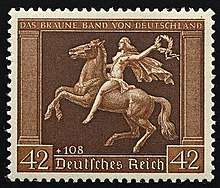
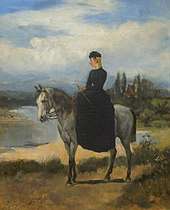
Niketas Choniates wrote that when the Germans attacked during the Emperor Manuel I Komnenos reign, females were numbered among them riding horses and bearing weapons and they were like the Amazons. Added that one stood out from the rest as another Penthesilea.[152][153]
Francisco de Orellana gave the Amazon river its name after reporting pitched battles with tribes of female warriors, whom he likened to the Amazons.[154]
The city of Samsun in modern-day Turkey features a recently constructed "Amazon Village" museum, created to bring attention to the legacy of the Amazons and to generate both academic interest and popular tourism.[155] A festival is also held every year in the Terme district of Samsun Province to celebrate the Amazons.[155]
In Greece, female equestrians are also called "Amazons" (Greek: Αμαζόνες).
Amazons became an important subject of the fine arts around 1900, especially in the work of the Munich painter and sculptor Franz Stuck (1863–1928).
In Nazi Germany open air events called "Nacht der Amazonen" (Night of the Amazons) were performed at Nymphenburg Palace in Munich between 1936 and 1939. These revues with bare-breasted girls presented an allegedly emancipated female role as part of the "new race" intended to be realized by racial fanatics.
In psychology
The study by Carl Jung of the sexual archetypes has been studied extensively under the collective title of the Jungian archetypes. The sexual archetypes, which include feminist archetypes depicted by Amazonian cultural portrayals, are used to elaborate and clarify various academic and sociological approaches taken to interpret both human sexuality and feminist views on sexuality.
In literature and media
Literature
- Amazon Queen Hippolyta appears in William Shakespeare's play A Midsummer Night's Dream and also in The Two Noble Kinsmen, which Shakespeare co-wrote with John Fletcher.
- The Amazon queen Penthesilea, and her sexual frenzy, are at the center of the drama Penthesilea by Heinrich von Kleist in 1808.
- The Amazon queen Antiope and War Leader, Eleutheria, known to history as Molpadia, appears in Steven Pressfield's novel Last of the Amazons published in 2002.
- William Moulton Marston, alongside his wife and their lover, created a fictional race of Amazons, whose members included the superheroine Wonder Woman, for DC Comics.
- In Marvel Comics fictional universe Hippolyta (a villain like Thanos) and Delphyne Gorgon are Amazons.
- In Rick Riordan's The Heroes of Olympus, the Amazons appear in The Son of Neptune and The Blood of Olympus. They are the founders and owners of the Amazon corporation.
- In Philip Armstrong's historical-fantasy series, The Chronicles of Tupiluliuma, the Amazons appear as the Am'azzi.
- In the Stieg Larsson novel The Girl Who Kicked the Hornet's Nest, the Amazons appear as the transitional topics between sections of the book.
- Garci Rodríguez de Montalvo created the fictional queen Calafia, who ruled over a kingdom of black women, living in the style of Amazons, on the mythical Island of California.
- Amazon Gazonga is a short comic series created by the Waltrip brothers in 1995. The comic centres around on a young amazon named Gazonga living in the Amazon rainforest.
Film and television
- Franchises involving Tarzan have featured Amazon tribes:
- A tribe of Amazons were in the film Tarzan and the Amazons.
- A tribe of Amazons appeared in the Tarzan, Lord of the Jungle episode "Tarzan and the Amazon Princess."
- In the animated series The Mysterious Cities of Gold, a tribe of Amazons appeared in episodes 21 ("The Amazons") and 22 ("The Mirror of the Moon").
- Frank Hart, portraying a sexual bigot, is kidnapped by Amazons in the 1980 film of sexual conflicts titled 9 to 5.[156]
- In the 1960 film The Loves of Hercules, a tribe of amazons lead by Queen Hippolyta serve as minor antagonists.
- In the 1973 film Battle of the Amazons, a tribe of amazons raid nearby villages for young men used for breeding and slavery.
- In the 1973 film War Goddess (also known as The Amazons) centres around a tribe of Amazons in the age of swords and chariots. The film has heavy influences from Greek mythology.
- In the 1983 film Hundra the titular character is the last survivor of a tribe of Amazons.
- In the 1986 Amazons movie, Amazons are featured prominently.
- The sequel to the original film, Deathstalker II 1987 features a tribe of amazon warriors.
- In the television series Hercules: The Legendary Journeys, Young Hercules, and Xena: Warrior Princess, several tribes of Amazons are featured, with numerous recurring characters including Gabrielle, Atalanta, and Amarice.
- In the television series The Legend of the Hidden City, Princess Kama's bodyguards are Amazons led by Commander Nefret.
- In the animated series Huntik: Secrets & Seekers, Queen Hippolyta and the Amazons appear in the episode Ladies' Choice.
- In the 2011 animated film Ronal the Barbarian, two of the male main characters are captured by a tribe of Amazons.
- In the 2014 Hercules movie, a character named Atalanta is depicted as an Amazonian archer and a member of Hercules' traveling band of mercenaries.
- In the season 7 episode 'The Slice Girls' of Supernatural, Amazons appear, as they kill their fathers. One of them seduces Dean Winchester and has a child, who quickly ages to a teenager and attempts to kill him, only to be shot by Sam Winchester.
- The myth of the Amazons features prominently in the 2017 hit DC film Wonder Woman portrayed by an immortal Amazon warrior goddess called Diana.
- In DC's Legends of Tomorrow, Helen of Troy is taken out of her time and left with the Amazons to train and becomes one of them.
Games
- In the Diablo video games, in the realm of Sanctuary, Askari people, also called Amazons, exist in the Queendom of the Skovos Isles.
- In Heroes Unlimited and Aliens Unlimited text roleplaying games, there is a race called the Atorians who can be considered Amazons.
- In Amazon: Guardians of Eden (which is a tribute to retro b-movies) a secretive tribe of Amazons is found in the Amazon basin.
- In Flight of the Amazon Queen a tribe of Amazons is found in a lost world somewhere in South America, kidnapped by a german mad scientist to be used as his army.
- In Rome: Total War the Amazons exist as a rebel sub-faction in a remote region on the north side of the campaign map. The capital of this region is Thermiskyra.
- In Final Fantasy IV the kingdom of Troia has matriarchal society, where women fill roles, traditional for males.
- In Age of Wonders Planetfall one of the playable factions are a group of terraforming genetically altered all female scientists called "Amazons".
- In the Legend of Zelda series, NPCs called Gerudo are heavily inspired by the Amazons.
- In Yu-Gi-Oh games, there are an arquetype called "Amazoness".
Military units
- Grigory Potemkin, a Russian military leader, statesman, nobleman and favourite of Catherine the Great created an Amazons Company in 1787. Wives and daughters of the soldiers of the Greek Battalion of Balaklava were enlisted and formed this unit.
- The Dahomey Amazons were an all-female military regiment of the Kingdom of Dahomey in present-day Benin – the nickname was given by western observers.
- HMS Amazon
Movements
- During the period 1905–1913, members of the militant Suffragette movement were frequently referred to as "Amazons" in books and newspaper articles.[157]
- In Ukraine Katerina Tarnovska leads a group called the Asgarda which claims to be a new tribe of Amazons.[158] Tarnovska believes that the Amazons are the direct ancestors of Ukrainian women, and she has created an all-female martial art for her group, based on another form of fighting called Combat Hopak, but with a special emphasis on self-defense.[158]
See also
|
|
References
Notes
- "ARES FAMILY - Greek Mythology". www.theoi.com.
- "Argonautica: Book 2: line 911". sacred-texts.com.
- "Lysias, Funeral Oration, section 4". www.perseus.tufts.edu.
- "Isocrates, Panegyricus, section 68". www.perseus.tufts.edu.
- "Isocrates, Panathenaicus, section 193". www.perseus.tufts.edu.
- "Philostratus the Athenian, Heroicus, olpage 750". www.perseus.tufts.edu.
- "The History of Herodotus, parallel English/Greek: Book 4: Melpomene: 110". www.sacred-texts.com.
- "Religious Cults Associated with the Amazons: Chapter I: The Amazons in Greek Legend". www.sacred-texts.com.
- "LacusCurtius • Diodorus Siculus — Book III Chapters 49‑61". penelope.uchicago.edu.
- "AESCHYLUS, PROMETHEUS BOUND - Theoi Classical Texts Library". www.theoi.com.
- Roman, L., & Roman, M. (2010). Encyclopedia of Greek and Roman mythology., p. 56, at Google Books
- Simon, Worrall. "Amazon Warriors Did Indeed Fight and Die Like Men". National Geographic. Retrieved 13 September 2016.
- Foreman, Amanda. "The Amazon Women: Is There Any Truth Behind the Myth?". Smithsonian.com. Smithsonian Institution. Retrieved 14 September 2016.
- Steinem, Gloria; Chesler, Phyllis; Feitler, Bea (1972). Wonder Woman. Hole, Rinehart and Winston and Warner Books. ISBN 0-03-005376-5.
- Palaephatus On Unbelievable Tales
- Stern, Jacob (1 January 1996). On Unbelievable Tales. Bolchazy-Carducci Publishers. ISBN 9780865163201 – via Google Books.
- Hansen, William F. (26 April 2005). Classical Mythology: A Guide to the Mythical World of the Greeks and Romans. Oxford University Press. ISBN 9780195300352 – via Google Books.
- Schuster, Ruth (2 January 2020). "Tomb with Three Generations of 'Amazon' Warrior Women Found in Russia". Haaretz.
- Lagercrantz, Xenia Lidéniana (1912), 270ff., cited after Hjalmar Frisk, Greek Etymological Dictionary (1960–1970)
- Jacobsohn, KZ 54, 278ff., cited after Hjalmar Frisk (1960–1970).
- Hinge 2005, pp. 94–98
- Pollauer, Gerhard (2010). The Lost History of the Amazons: Recent research findings on the legendary women nation. Lulu.com. p. 107. ISBN 978-1-4461-9305-1.
- Justinus' "Historiae Phillippicae ex Trogo Pompeio", Liber II, 4: "Virgines (...) armis, equis, venationibus exercebant, inustis infantum dexterioribus mammis, ne sagittarum iactus impediantur; unde dictae Amazones." "They exercised the virgins on weapon-wielding, horse-riding and hunting, and burned the children's right breasts, so that arrow-throwing wouldn't be impeded; and for such reason, they were called Amazons."
- Haynes, Natalie (16 October 2014). "The Amazons: Lives & Legends of Warrior Women Across the Ancient World by Adrienne Mayor, book review". The Independent. Retrieved 6 April 2015.
-

- "Adrienne Mayor, Start the Week, Radio Four". bbc.co.uk. 6 April 2015. Event occurs at 21:30.
- Herodotus: Histories, 4.110.1.
- STRABO, GEOGRAPHY, Book XI, Chapter 5

- "Plutarch • Life of Theseus". penelope.uchicago.edu.
- "Pseudo-Plutarch, De fluviis, XIV. TANAIS". www.perseus.tufts.edu.
- Stadiasm. Mar. Mag., ed. Hoffmann, p. 488.
- "Aeschylus, Prometheus Bound, line 696". www.perseus.tufts.edu.
- "Aeschylus, Suppliant Women, line 274". www.perseus.tufts.edu.
- "Euripides, Hippolytus, line 581". www.perseus.tufts.edu.
- "Διονυσιακά/36 - Βικιθήκη". el.wikisource.org.
- P. Walcot, "Greek Attitudes towards Women: The Mythological Evidence", in: Greece & Rome, 2nd Series, 31.1 (April 1984), pp. 37–47, esp. 42.
- Homer, Iliad iii. 189.
- In the Aethiopis, a continuation of the Iliad. The epic, by Arctinus of Miletus, is lost; only references to it survive.
- Quintus Smyrnaeus, i. 699.
- Justin, ii. 4.
- Virgil, Aeneid i. 490.
- Pausanias, Description of Greece v. 11, § 2.
- Philostratus, Her. xix. 19.
- Homer, Iliad vi. 186, &c.
- Scholiast On Lycophron 17
- "Pindar, Olympian, Olympian 13 For Xenophon of Corinth Foot Race and Pentathlon 464 B. C." www.perseus.tufts.edu.
- Homer, Iliad, Book ii. 45–46; Book iii. 52–55.
- Blundel, Sue (1995). Women in Ancient Greece. Sara F. Yoseloff Memorial Publications. Cambridge, MA: Harvard University Press. p. 60. ISBN 9780674954731. Retrieved 3 March 2020.
For other ancient authors the Amazons, in spite of their separatist habits, were not immune to the lure of sexual desire. The fifth-century historian Herodotus recounts how some Amazons from Themiscyra who had been taken prisoner...
- ARGONAUTICA BOOK 2, 994–1001
- "Argonautica: Book 2: line 301". sacred-texts.com.
- "Pliny the Elder, The Natural History, BOOK VI. AN ACCOUNT OF COUNTRIES, NATIONS, SEAS, TOWNS, HAVENS, MOUNTAINS, RIVERS, DISTANCES, AND PEOPLES WHO NOW EXIST, OR FORMERLY EXISTED., CHAP. 13. (12.)—THE ISLANDS OF THE EUXINE". www.perseus.tufts.edu.
- Adrienne Mayor (22 September 2014). The Amazons: Lives and Legends of Warrior Women across the Ancient World. Princeton University Press. p. 165. ISBN 978-1-4008-6513-0.
- Michael Grant; John Hazel (2 August 2004). Who's Who in Classical Mythology. Routledge. pp. 106–. ISBN 978-1-134-50942-3.
- Tobias Fischer-Hansen; Birte Poulsen (2009). From Artemis to Diana: The Goddess of Man and Beast. Museum Tusculanum Press. p. 333. ISBN 978-87-635-0788-2.
- Apollonius Rhodius, Argonautica "Zeus once more sent forth Boreas (the North Wind), and with his help the Argonauts stood out from the curving shore where the Amazons of Themiskyra were arming for battle."
- Pseudo-Apollodorus, Bibliotheca ii. 5.
- Diodorus Siculus, Bibliotheca historica iv. 16.
- Gaius Julius Hyginus, Fabulae 30.
- Quintus Smyrnaeus, xi. 244.
- Pausanias, Description of Greece i. 2
- Plutarch, Theseus 26–28
- "ToposText". topostext.org.
- "Aeschylus, Eumenides, line 674". www.perseus.tufts.edu.
- Greek Alexander Romance, 3.25–26
- Plutarch, Life of Alexander, Chapter 46
- Mayor, Adrienne (22 September 2014). The Amazons: Lives and Legends of Warrior Women across the Ancient World. Princeton University Press. ISBN 9781400865130 – via Google Books.
- "Plutarch, Quaestiones Graecae, section 56". www.perseus.tufts.edu.
- "Eusebius' Chronicle, Greek Chronicle, Castor, Porphyrius". www.attalus.org.
- "LacusCurtius • Diodorus Siculus — Book III Chapters 62‑74". penelope.uchicago.edu.
- "Capitains Nemo". cts.perseids.org.
- "ToposText". topostext.org.
- Digenis Akritas: the Two-Blood Border Lord, translated by Denison B. Hull, 1972, Ohio University Press, G-vi, 385–387, p. 82.
- Quintus Smyrnaeus, Posthomerica I
- Diodorus Siculus, Bibliotheca historica IV. 16
- Diodorus Siculus, Bibliotheca historica III. 53-55
- "Justinus: Epitome of Pompeius Trogus' Philippic Histories 2.4". Retrieved 2020-05-10.
- Paulus Orosius, Historiae adversus paganos, I. 15
- Scholia on Pindar, Nemean Ode 3. 64
- Gaius Julius Hyginus, Fabulae 163
- Gaius Julius Hyginus, Fabulae 30
- Gaius Julius Hyginus, Fabulae 112
- Apollodorus, Bibliotheca E5. 1
- Gaius Julius Hyginus, Fabulae 223, 225
- Apollonius Rhodius, Argonautica 2. 370 ff and 382 ff
- Valerius Flaccus, Argonautica, 6. 370–377
- Latin Anthology, 392 (Traiani Imperatoris e Bello Parthico versus decori), ed. Riese
- Tzetzes, Posthomerica, 176–183
- Stephanus of Byzantium, s. v. Thibaïs
- Eustathius on Dionysius Periegetes, 828
- Demosthenes in Stephanus of Byzantium s. v. Amastris
- Strabo, Geography, 12. 3. 11
- Stephanus of Byzantium s. v. Anaia
- Smith, William (26 April 1844). "Dictionary of Greek and Roman Biography and Mythology". Taylor and Walton – via Google Books.
- Stephanus of Byzantium, s. v. Kyme
- Stephanus of Byzantium, s. v. Kynna. Stephanus does not write out the Amazon's name, simply stating that the town Cynna could have been named "after one of the Amazons".
- Etymologicum Magnum 402. 8, under Ephesos
- Stephanus of Byzantium, s. v. Ephesos
- Stephanus of Byzantium, s. v. Myrleia
- Stephanus of Byzantium, s. v. Σίσυρβα
- Strabo, Geography, 14. 1. 4
- Stephanus of Byzantium, ss. vv. Smyrna, Ephesos
- Strabo, Geography, 11. 5. 5; 12. 3. 22; 14. 1. 4
- Pritchett, W. Kendrick (1998). Studies in ancient Greek topography: Passes. University of California Press. p. 276. ISBN 978-0-520-09660-8. Retrieved 30 September 2010.
- Sextus Pompeius Festus, s. v. Aegeum Mare
- New York, Metropolitan Museum of Art 42.11.33, c. 600. LIMC, "Achilleus" no. 720*.
- "Perseus Digital Library – Description of the Tyrrhenian amphora". Perseus.tufts.edu. 1990-01-24. Retrieved 2014-01-25.
- "Perseus:image:1990.24.0349".
- Mimnermus, Fragment 21a
- J H Blok (1995). The Early Amazons: Modern and Ancient Perspectives on a Persistent Myth. BRILL. p. 218. ISBN 978-90-04-10077-0.
- Tzetzes on Lycophron, 995
- Müller, Karl; Müller, Theodor; Langlois, Victor (1849). Fragmenta historicorum Graecorum. Didot. p. 595.
- F. A. Ukert, Die Amazonen, Abhandlungen der philosophisch-philologischen Classe der Königlich Bayerischen Akademie der Wissenschaften (1849).
- "Eurypyle". Brooklynmuseum.org. 2007-03-21. Retrieved 2014-01-25.
- Servius on Aeneid, 4. 345
- William Smith, Dictionary of Greek and Roman Biography and Mythology, v. 2, page 315 Archived 2010-10-26 at the Wayback Machine
- Ptolemy Hephaestion, New History, 4, summarized in Photius, Bibliotheca, 190, although the source does not explicitly state that she was an Amazon
- Callimachus, Hymn 3 to Artemis, 239 & 267
- Athenaeus, Banquet of the Learned, 1. 31D (p 139), with a reference to Alciphron of Maeander
- Pseudo-Plutarch, On Rivers, 14
- Plutarch, Theseus, 27
- Scholia on Apollonius Rhodius, Argonautica, 1. 752; compare also Pausanias, Description of Greece, 8. 14. 8, where it is deemed likely that the Myrtoan Sea takes its name from a certain woman named Myrto
- Hyginus, Fabulae, 224
- Scholia on Apollonius Rhodius, Argonautica, 2. 946
- Appian, Mithridatic Wars, 78
- Eustathius on Homer, Iliad 2. 814
- "The Internet Classics Archive | Theseus by Plutarch". 2010-09-02. Retrieved 2010-09-07.
- Mary Bennett, Florence (December 2007). Religious Cults Associated With the Amazons. Forgotten Books. ISBN 978-1605063867.
- "Pausanias, Description of Greece, Attica, chapter 2". www.perseus.tufts.edu.
- "Plato-Spuria I". www.poesialatina.it.
- "Ancient History Sourcebook: Pausanias: Description of Greece, Book I: Attica". Fordham.edu. Retrieved 2014-01-25.
- "Harpocration, Valerius, Lexicon in decem oratores Atticos, λεττερ α, ἈΜΑΖΟΝΕΙΟΝ". www.perseus.tufts.edu.
- "SECRETS OF THE DEAD . Amazon Warrior Women. Clues and Evidence". PBS. Retrieved 2014-01-25.
- Mayor, Adrienne (2014). The Amazons: Lives and Legends of Warrior Women across the Ancient World.
- "Lucian, Imagines, section 4". www.perseus.tufts.edu.
- Schleiner, Winfried (1978-04-01). "'Divina Virago': Queen Elizabeth as an Amazon". Studies in Philology. 75 (2): 163–180. JSTOR 4173965.
- "German masters of the nineteenth century : paintings and drawings from the Federal Republic of Germany / The Metropolitan Museum of Art, New York :: Metropolitan Museum of Art Publications". libmma.contentdm.oclc.org. Retrieved 2015-09-30.
- "Xenophon, Anabasis, *ku/rou *)anaba/sews *d, chapter 4, section 16". www.perseus.tufts.edu.
- "Perseus Under Philologic: Hipp. Aer. 17".
- Naturalis Historia VI.3.10
- F. A. Ukert, Die Amazonen, Abhandlungen der philosophisch-philologischen Classe der Königlich Bayerischen Akademie der Wissenschaften (1849), 63..
- "Pausanias, Description of Greece, *lakwnika/, chapter 25, section 3". www.perseus.tufts.edu.
- It has been suggested that what Orellana actually engaged was an especially warlike tribe of Native Americans whose warrior men had long hair and thus appeared to him as women. See Theobaldo Miranda Santos, Lendas e mitos do Brasil ("Brazil's legends and myths"), Companhia Editora Nacional, 1979.
- Ukert (1849), p. 35.
- The Travels of Sir John Mandeville, Dover publications, Mineola, New York, 2006, cap. XVII, p. 103-104
- "Lyn Webster Wilde, 'Did the Amazons really exist?'". Diotima. Archived from the original on 2017-05-25. Retrieved 2014-01-25.
- Anthony, David W. (2007). The Horse, the Wheel, and Language: How Bronze-Age Riders from the Eurasian Steppes Shaped the Modern World. Princeton University Press. ISBN 978-0-691-05887-0.
- "Diotima". Stoa.org. Archived from the original on 2017-05-25. Retrieved 2014-01-25.
- "Warrior Women of Eurasia", Archaeology Magazine (Abstract) Volume 50 Number 1, January/February 1997 Retrieved 7/10/08.
- In a recent excavation of Sarmatian sites by Dr. Jeannine Davis-Kimball, a tomb was found wherein female warriors were buried.
- L.R. Farnell and J.L. Myres, "Herodotus and anthropology" in Robert R. Marett Anthropology and the Classics 1908, pp. 138ff.
- (pp. 153 ff)
- "ToposText". topostext.org.
- "Νικήτας Χωνιάτης - Χρονική Διήγησις". users.uoa.gr.
- Amazon River, in Britannica.
- "Village of Amazons to be recreated in Samsun park – Today's Zaman, your gateway to Turkish daily news". Todayszaman.com. 2010-06-10. Archived from the original on 2014-02-01. Retrieved 2014-01-25.
- "9 to 5". TV Tropes. Retrieved 27 August 2018.
- Wilson, Gretchen "With All Her Might: The Life of Gertrude Harding, Militant Suffragette" (Holmes & Meier Publishing, April 1998)
- "Ukraine's Asgarda martial arts program recasts Amazon warrior women | Public Radio International". Pri.org. Retrieved 2014-01-25.
Further reading
- Bergmann, F. G. Les Amazones dans l'histoire et dans la fable (1853) (in French)
- Blok, Josine H. (Peter Mason, tr.), The Early Amazons: Modern and Ancient Perspectives on a Persistent Myth (1995)
- Grote, George/History of Greece, pt. i, ch. 11.
- Hinge, George (2005). "Herodot zur skythischen Sprache. Arimaspen, Amazonen und die Entdeckung des Schwarzen Meeres". Glotta (in German). 81: 86–115.CS1 maint: ref=harv (link)
- Klugmann, A. Die Amazonen in der attischen Literatur und Kunst (1875) (in German)
- Krause, H. L. Die Amazonensage (1893) (in German)
- Lacour, F. Les Amazones (1901) (in French)
- Lexicon Iconographicum Mythologiae Classicae, vol. I, s.v. "Amazones".
- Mayor, Adrienne. The Amazons: Lives and Legends of Warrior Women across the Ancient World, Princeton University Press, 2014
- Mayor, Adrienne (2017). "Amazons in the Iranian World". Encyclopaedia Iranica.
- Mordtmann, Andreas David. Die Amazonen (Hanover, 1862) (in German)
- Pauly-Wissowa, Realencyclopädie der Classischen Altertumswissenschaft
- Roscher, W. H., Ausführliches Lexikon der griechischen und römischen Mythologie (in German)
- Rothman, Joshua. The Real Amazons, The New Yorker, October 17, 2014
- Samuel, Pierre. "Les amazones: mythes, réalités, images". In: Les Cahiers du GRIF, n°14-15, 1976. Violence. pp. 10-17. [DOI: https://doi.org/10.3406/grif.1976.1113] ; www.persee.fr/doc/grif_0770-6081_1976_num_14_1_1113
- Shahbazi, A.S. (1989). "Amazons". Encyclopaedia Iranica, Vol. I, Fasc. 9. p. 929.
- Santos, Theobaldo Miranda. Lendas e mitos do Brasil (Companhia Editora Nacional, 1979) (in Portuguese)
- Stricker, W. Die Amazonen in Sage und Geschichte (1868) (in German)
- von Rothmer, Dietrich, Amazons in Greek Art (Oxford University Press, 1957)
- Wright, Celeste Turner. "The Amazons in Elizabethan Literature." Studies in Philology 37, no. 3 (1940): 433-56. Accessed June 28, 2020. www.jstor.org/stable/4172492.
External links
| Wikimedia Commons has media related to Amazons. |
| Look up Amazon in Wiktionary, the free dictionary. |
| Wikiquote has quotations related to: Amazons |
| Wikisource has the text of the 1911 Encyclopædia Britannica article Amazons. |
- . New International Encyclopedia. 1905.
- Wounded Amazon
- Herodotus on the Amazons
- Straight Dope: Amazons
- Religious cults associated with the Amazons (Florence Mary Bennett, 1912)
- Amazon women in Mongolian steppe
- Amazon women mtDNA found in Mongolia
- Warburg Institute Iconographic Database (ca 225 images of Amazons)
.jpg)